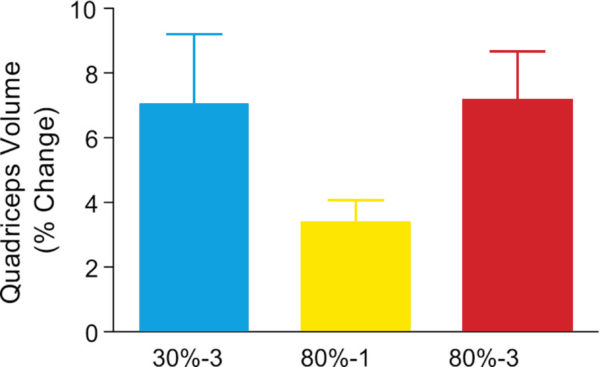The science of big muscles is supposed to be simple and intuitive. Use light weights for high reps to build muscle endurance. Then use heavy weight for very low reps to build strength. Meet in the middle of these two extremes and you have the coveted “hypertrophy zone”, where moderately heavy weight is touted as the best option to build muscle. Easy, huh? Well, not so fast – research has recently challenged this theory.
This theory was first challenged in a paper in >the Journal of Applied Physiology where researchers gathered 18 male subjects to train their legs on the leg extension machine three times a week for 10 weeks.
They were separated into three groups:
- Group 1 performed 3 sets at 30% of their 1RM for 30-40 reps
- Group 2 performed 1 set at 80% of their 1RM for 10-12 reps
- Group 3 performed 3 sets at 80% of their 1RM for 10-12 reps
The result?

As seen in the graph above, quadriceps muscle growth was nearly identical in groups 1 and 3. Meaning that both the light weight and heavy weight groups gained equivalent muscle mass when volume (# of sets) was taken into account. This was a novel finding at the time, but it attracted a lot of skepticism because it used untrained beginners as subjects.
Since we know that untrained individuals will respond and grow to basically any stimulus you throw at them, it may have been the underlying cause of the results seen in this study.
The More Experienced Lifter
Because you can’t just challenge the foundation of muscle building without coming at it from a new angle, the researchers performed a similar study published in >the Journal of Applied Physiology. But this time they used 49 men with an average of four years lifting experience. The results? Once again, the results showed that load did not dictate hypertrophy, meaning that both light weights and heavy weights elicited equal amounts of muscle growth. After this study, several studies in >The Journal of Strength and Conditioning Research and a meta-analysis in the >European Journal of Sport and Science have been done on the topic. They all concluded with the same result: “light weights and heavy weights led to similar muscle growth when volume is equated for and sets are taken close to failure.”
Case Closed On Big Weights?
Based on these findings it might seem as if you can pick up pretty much any weight and see equivalent muscle growth from it, as long as volume is equated and matched.
But, as with many things, there are a few things to consider.
Heavy Advantage
When looking at strength, the meta-analysis in >European Journal of Sport and Science of eight relevant studies comparing heavy versus light weights showed that the use of heavy weights tends to be better in terms of strength gains. Which in the long run, could lead to better hypertrophy when compared to lighter weights given the correlation we see between strength and size.
Failure Factor
Keep in mind that these studies involved the use of pushing to near failure during each sets (1-3 reps short of complete failure) regardless of the weight used. This is because when you’re using a lighter weight, you still have to push your muscles close enough to fatigue in order to fully activate the motor units of that muscle. Otherwise, you won’t see comparable growth. And training to failure in a higher rep range is a lot more uncomfortable than doing so with lower reps and heavier weights due to the increased metabolic stress. In fact, some of the subjects performing the light weight protocols even ended up throwing up after high rep sets. Think about it – would you rather do a set of light squats for a grueling set of 20 reps, or a moderately heavy set of squats for a set of 10 reps? It’s easy to know which one most people would pick.
Relatively Light
There seems to be a cut-off with regards to how light you can go to build muscle. Research in >The Journal of Applied Physiology indicates that anywhere below about 30% of your 1 rep max seems to be detrimental to growth. Meaning that if you are using a weight that you can perform 30-40 reps on in one set, then that’s an indication that the weight is too light if you’re seeking to maximize growth.
So, generally speaking, it actually does seem to be best to stick to a moderately heavy weight (~70-80% of your 1 rep max) if you’re seeking to maximize muscle growth. However, it’s >not because it’s some “magical zone” where muscle growth occurs. It’s simply because it’s the most convenient way for you to take your muscles to near failure each set and accumulate more volume in your workouts.
Don’t Discount Light Weights
On that note, it’s important to realize that this research does present an opportunity to use lighter weights to build muscle. In the event that you’re struggling with a nagging injury or you are stuck with limited equipment (e.g. working out at home), then you can rest assured that you can still build just as much muscle using lighter weights.
This is provided you are still taking each set close enough to failure and as long as the weight you use isn’t too light (below ~30% of your 1RM). It seems that using a moderately heavy weight does actually make the most sense if you’re seeking to prioritize muscle growth. However, realize that you can build muscle with any weight you choose as long you are still doing enough volume, taking each set to close enough failure, and not using a weight that’s too light. This has important applications to certain demographics and scenarios where lighter weights would be the better choice.







